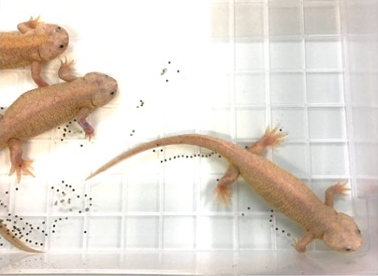器官再生メカニズム研究グループ
研究紹介
有尾両生類に属するイモリは、極めて強い再生能力を持っています。彼らは四肢や尾、顎に加えて、角膜や網膜、脊髄、さらには脳や心臓までも再生することができます。これに対して私たちヒトやマウスの再生能力は極めて限定的です。同じ脊椎動物(背骨のある動物)でありながら、どうしてこのような大きな違いが生じるのでしょうか?
私たちは繁殖力に優れたスペイン原産のイベリアトゲイモリをモデルとして、この器官再生の機構、すなわち再生を可能とする仕組みと再生ができない原因を明らかにする研究に取り組んでいます。
また、国内外の研究者がイベリアトゲイモリを利用できるように、本種をリソース化するための研究や活動も行っています。

最近のトピック
- 器官再生メカニズム研究グループ大学院生の諸角氏と岡本助教、林教授らのグループによるイモリの膵臓形成に関する研究成果が、国際科学誌Developmental Dynamics誌に掲載されました。 2025-01-28
- 器官再生メカニズム研究グループ大学院生の中尾氏と岡本助教、林教授らのグループによるイモリの胚発生におけるCDK1遺伝子の機能に関する研究成果が、国際科学誌Development Growth & Differentiation誌に掲載されました。 2025-01-28
- (7/31-8/2)国際会議Salamander Meeting 2024を開催しました。 2024-08-03
- イモリが去勢後におこる体重増加の仕組みを研究するモデルとなることを報告しました 2024-01-13
- イモリが腱を再生できる機構にマウスとの比較解析から迫る 2023-10-13
研究室の1コマ

リューシスティック系統のイモリの産卵の様子です。このイモリは体表に黒色色素細胞が無い自然突然変異体ですが、黒い色素を持った卵を産みます。
スタッフ
*「広島大学研究者総覧」では教員の連絡先、教育担当状況、研究業績などが閲覧できます(公開項目は教員によって異なります)。
学生・大学院生
竹原 舞( D2)
榎本 英理子(D1)
阿南 有紗(D1)
加本 拓海(M2)
清家 龍翔(M2)
山根 大和(M2)
暮石 琴乃(M2)
徐 俊傑(M2)
平野 笑夢(M2)
田方 龍真(M1)
塚本 優太(M1)
小林 紗夏(M1)
中尾 遥(B4)
増本 直希(B4)
グループからのメッセージ
私たちの研究室では学部学生や大学院生を募集しています。器官再生メカニズムの解明を目指した研究を行いたい方、イモリの驚異的な能力に興味のある皆さんの参加を待っています。
また、学内外の方々とも、イベリアトゲイモリを介した共同研究に積極的に取り組みたいと考えています。イベリアトゲイモリは、再生能力やがん化耐性の他にもたくさんの有用な能力や興味深い性質を持っています。興味がある方は、ぜひご連絡をください。

